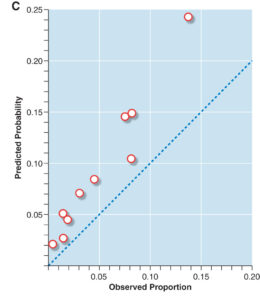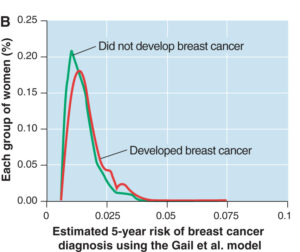Select the best answer. These questions are for self-study only. Answers will not be evaluated or saved.
Question 1
In the mid-20th century, chest surgeons in Britain were impressed that they were operating on more men with lung cancer, most of whom were smoking. How might the surgeons' impression that smoking was a risk factor for developing lung cancer have been wrong?
When a risk factor is common in a population, it is important to compare its prevalence in people with and without disease. There is no comparison in the example. Lung cancer is a common cancer, and smoking is a strong, not weak, risk factor for cancer. The fact that there are other risk factors for lung cancer is not relevant.
Question 2
Risk factors are easier to recognize:
Risk factors are sought when a new disease appears, as was the case with HIV.
Question 3
Risk prediction models are useful for:
Risk prediction models are used in all situations.
Question 4
This figure (5.4C) shows:
Calibration plots show the predicted vs. observed rates for a prediction model. The example with Figure 5.4C has plots where the predicted rates from the model are consistently higher than the actual observed rates for the population under study.
Question 5
A risk model for colon cancer estimates that one of your patients has a 2% chance of developing colorectal cancer in the next 5 years. In explaining this to your patient, which of the following statements is most correct?
The patient is unlikely to develop colorectal cancer in the next 5 years because he is a member of the group with a low probability, but he could be one of the 2% who develops the disease. Even for common cancer, there are subgroups of people with a low probability of developing it. For example, few young people develop colorectal cancer.
Question 6
When a risk factor is a marker for future disease:
Question 7
A risk factor is generally least useful in:
Symptoms, physical examination findings, and laboratory tests are generally more important than risk factors when diagnosing disease.
Question 8
This figure (5.3B) shows that:
The overlap of the two groups demonstrates that the risk model does not discriminate well between women who did and did not develop breast cancer over 5 years. The figure gives no direct information about calibration and stratification. Few women who developed breast cancer were at high risk.
Question 9
It is difficult for risk models to determine which individuals will and will not develop disease for all the following reasons except:
Good calibration does not impair discrimination. However, risk models can discriminate poorly even if they are highly calibrated, as the example in the text shows.
Question 10
Which of the following is incorrect?
Diagnostic tests and prediction models can have similar assessment methods. Calibration tends to be more important in assessing prediction models and can provide useful information even if discrimination is not good.




